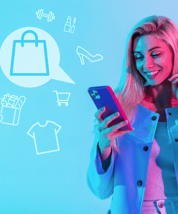Introduction
Since the early 2020s, the boundaries between the physical and digital worlds have become increasingly blurred. In this context, phygital has emerged as a strategic and indispensable concept to meet consumer expectations.
This innovative combination completely reimagines the customer experience, the idea of retail stores, and marketing communication as a whole.
Phygital: A revolution in customer experience
1. Phygital: Definition
Phygital is the balanced fusion of physical and digital assets to provide customers with a more customized and seamless experience. This new approach has emerged from the growing consumer demand for more flexibility, efficiency, and innovation.
2. Expectations of Modern Consumers
A phygital store offers visitors a simplified shopping journey using tools like QR codes or interactive kiosks. These solutions combine the practicality of e-commerce with human interaction, thereby enhancing user engagement and loyalty. Phygital creates opportunities for more immediate and attractive interactions.
Technologies driving digital transformation
Various methods and technologies can be utilized to create unique hybrid experiences in a phygital store:
1. QR Codes and RFID
QR codes and RFID improve traceability and provide quick access to information, benefiting both customers and staff.
2. Augmented and Virtual reality
Augmented and virtual reality offers consumers immersive phygital experiences. For example, IKEA has launched a mobile app allowing customers to visualize furniture in their homes and create tailored layouts.
3. Interactive kiosks and smart sensors
Interactive kiosks and smart sensors enhance customer independence and offer a more personalized experience tailored to their needs.
4. Connected Apps
Mobile apps ensure continuity between online and offline channels, providing real-time information on product and service availability.
These creative and innovative technologies are building a more digital commerce model, enhancing process efficiency and delivering a high-quality hybrid customer experience.
Opportunities for brands in phygital
This revolution in customer engagement opens up numerous opportunities for brands to stand out.
1. Enhancing customer engagement
Companies like Nike have implemented fully immersive customer journeys. For example, customers can unlock special in-store offers, participate in challenges, or receive personalized rewards through the Nike app. This fosters a strong emotional bond with users. Organizing connected in-store events is also a great way to create a sense of proximity and offer consumers fun activities around your products and services.
2. Boosting sales through personalization
By analyzing customer data and addressing friction points in the customer journey, you can rethink the experience to offer more fluidity and personalization. Coupled with effective synchronization of offline and online stock through a structured ecosystem, purchase opportunities are maximized.
3. Building loyalty through unique experiences
Developing an omnichannel loyalty program, such as Amazon Go, transforms each visit into a unique and memorable phygital experience for customers. Staying ahead of trends is also a great way to anticipate consumer expectations and capture their attention, leveraging tools like predictive analytics.
Challenges of implementing a phygital strategy
Although indispensable, implementing a phygital strategy presents challenges. It's crucial to anticipate these obstacles and structure your implementation plan effectively to fully enjoy the benefits of phygital.
1. Costs and technological implementation
Equipping physical stores with interactive kiosks or augmented reality solutions requires significant initial investment. These costs include hardware, software development, maintenance, and employee training to ensure smooth integration and customer satisfaction. For example, virtual fitting rooms in fashion stores come with high setup costs, but customer satisfaction and reduced returns often justify the investment.
2. System integration
Integrating all online and offline tools, such as CRM systems and in-store infrastructures, is one of the main challenges in establishing your phygital setup. Perfect synchronization between these systems ensures efficient data flow, allowing brands to track stock in real-time and personalize offers based on customer preferences.
3. Data privacy and security
With the growing use of digital technologies, consumers are increasingly aware of how their data is handled, demanding greater transparency and security. Regulations like GDPR and NLPD have been introduced to address these expectations. Compliance involves structured collection, storage, and usage of data, requiring frequent audits to identify security issues.
Inspiring success stories
Several brands have already tested and validated the effectiveness of a well-executed phygital strategy:
1. Nike Live: The perfect example of a connected store
Nike has created personalized store concepts tailored to specific geographic areas. For instance, its Los Angeles store offers products and promotions that align with local preferences. The store also hosts community-inspired events. Data from NikePlus allows personalized recommendations for members, creating a unique customer connection.
2. Sephora: diagnostics and personalization
Sephora developed a skin diagnostics technology that helps customers scan their skin tone to identify ideal products tailored to their needs. This kind of personalization enhances customer satisfaction in both service and product quality.
3. IKEA: Augmented reality and visualization
IKEA's augmented reality app, IKEA Place, allows customers to visualize furniture in their homes using their smartphones. This fun and practical tool helps customers make purchasing decisions and reduces product returns.
4. Zara: Efficient stock management
Zara integrates RFID technology into its online and offline ecosystems, improving stock management and streamlining the customer experience. Customers can independently check product availability in stores via the app, reducing frustration caused by stock shortages.
Practical guide to phygital transition
If you wish to develop a phygital concept for your brand, follow these tips for success:
Listen to your customers: Identify their journey, pinpoint friction points, and find areas for improvement.
Choose the right tools and technologies: Focus on solutions that meet your needs and budget. For smaller businesses, starting with QR codes might be sufficient.
Monitor and analyze performance: Use KPIs such as customer satisfaction, product return rates, or conversions to measure success.
Support your teams: Ensure all staff understand the implemented tools through regular training to maximize their use.
Relying on experts and specialists can also accelerate the implementation of your strategy and deliver measurable results.
Conclusion
Phygital combines the best of physical marketing and digital potential to reinvent the customer experience.
Despite its challenges, phygital offers exciting opportunities for brands willing to innovate and transform their marketing approach. Success lies in organization, planning, and personalization, guaranteeing a competitive, customer-centric strategy.
Far from being a passing trend, phygital reflects a structural shift in the relationship between consumers and brands. Take the lead by rethinking your strategy today.







